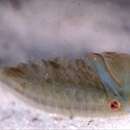Biology
provided by Arkive
The fairy shrimp has been found throughout the year, and has even been found in ice-covered water (3). It feeds on microscopic animals and organic particles, which are either taken from the water with the legs or scraped from the bottom of the pond (3). It has an extremely fast life-cycle, and fairy shrimp eggs are able to survive when the temporary pond habitat dries out; when they become wet once more they hatch, but some eggs remain dormant so that if conditions quickly deteriorate again, some eggs will survive (3). Various animals, including ponies, deer and cattle disperse the eggs from pool to pool (3).
Conservation
provided by Arkive
Several colonies of the fairy shrimp are located within Sites of Special Scientific Interest (SSSIs), however this does not seem to protect this species. Suitable habitats need active management, and cattle trampling and grazing should be encouraged (3). The fairy shrimp is fully protected in the UK under Schedule 5 of the Wildlife and Countryside Act 1981 and listed as a Species of Conservation Concern under the UK Biodiversity Action Plan, although not a priority species (2).
Description
provided by Arkive
The fairy shrimp is a beautiful, translucent crustacean, which lacks a carapace, and is considered to be rather primitive as it has a relatively large number of segments and the legs are not specialised (5). The body is elongated, and bears 11 pairs of legs fringed with bristles; the head curves downwards, and in males the second pair of antennae are modified 'claspers' for grabbing females during mating (6). Fairy shrimps swim around on their backs, propelled by the constantly moving legs (5).
Habitat
provided by Arkive
This species inhabits temporary pools, ranging from ponds to muddy ruts, and shows a preference for sites that are subject to regular disturbance by vehicles, livestock, or ploughing (livestock also enrich the site with their dung). The fairy shrimp cannot co-exist with fish and has a broad tolerance of varying levels of temperature, oxygen levels and water chemistry (3).
Range
provided by Arkive
This is the only fairy shrimp in Britain; it has formerly been recorded throughout much of England as far north as York, but has more recently become restricted to Devon, Cornwall, the New Forest, and Cambridgeshire (3). Elsewhere, it is found in continental Europe (3).
Status
provided by Arkive
Classified as Vulnerable in the British Red Data Book (3), fully protected in the UK under Schedule 5 of the Wildlife and Countryside Act 1981 and listed as a Species of Conservation Concern under the UK Biodiversity Action Plan, although not a priority species (4).
Threats
provided by Arkive
A main threat facing the fairy shrimp is the perception of its habitats as 'unsightly'; temporary pools are often infilled or converted to permanent ponds. Furthermore, water abstraction, causing a lowering of the water table and a loss of suitable habitat has also occurred at some sites. In the early 20th century, the fairy shrimp was known from common land in Buckinghamshire and Hertfordshire, but the decline of traditional grazing on the commons has eliminated suitable habitat through conversion to scrub and woodland (3).

